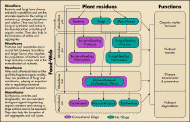
4.2 Biological Activity
Soil organisms (biota) carry out a wide range of processes
that are important for the maintenance of soil 'health' and fertility in
both natural and managed agricultural soils. The total number of
organisms, the diversity of species and the activity of the soil biota
will fluctuate as the soil environment changes. These changes may be
caused by natural or imposed systems.
Biota Facts
-
Soil organisms range in size from microscopic eg
bacteria, to centimetres, eg earthworms.
-
Their activity is concentrated in the top 10cm of top
soil.
-
Millions of organisms exist, but only a few have been
identified, eg 5% of fungi and 3% of nematodes.
-
80-90% of soil biological activity is carried out by
bacteria and fungi.
-
Resistance to extreme changes in the soil environment
improves as organisms decrease in size.
-
The reproductive interval reduces with a decrease in
organism size, eg bacteria reproduce themselves in hours, whilst
earthworms may take weeks.
-
In natural and managed environments a complex food web
exists. These 'predator-prey' relationships help control the balance
of species present in the soil.
-
When these relationships have evolved and a reduced
incidence of disease is recorded, such soils are termed
'suppressive'.
Functions of soil organisms
There is a two-way relationship between soil biota and
agricultural production. Plant residues provide sources of energy and
nutrients for the biota, which turn over organic matter (OM), improve
nutrient availability and soil structure, transmit and prevent disease and
degrade pollutants. Agricultural practices can be beneficial and
detrimental to the soil biota. Likewise, soil biota can increase or reduce
agricultural production.
How does Agriculture Influence Soil Biota Activity?
Any factor that changes the soil environment will impact
on the activity and diversity of soil biota. Different soil environments
support different types and numbers of biota, eg soils under a legume have
a higher level of rhizobia which fix nitrogen for that legume; after a
canola crop soil will have a lower level of root disease fungi because of
the fungicidal compounds released by the decomposing canola residues.
Agricultural production can result in increased soil
carbon inputs from retained crop residues, root residues and increased
nutrient levels from fertilisers. These increase biological activity.
Where organic matter declines, biological activity will also decline.
Different plant residues will contain varying quantities and availability
of carbon (energy), nitrogen and nutrients. This is expressed as a ratio
of carbon to nitrogen. The carbon nitrogen ratio (C:N) of biota is 6-10:1.
The closer the residue C:N ratio is to the biota C:N ratio, the more
readily it is broken down. Consequently, this will also influence the
soils biological activity.
|
Figure 1:
Soil biota carry out 5 key functions which interact with
production.

Different production systems alter the breakdown
food-web for plant residues.
Click for a larger image. |
Cultivation alters the physical, chemical and
biological components of the soil system. No-till/direct-drill systems
result in significant differences in soil organism activity compared to
conventional tillage (see Figure 1).
Agricultural inputs, such as fertilisers have been
shown to have both a positive and negative effect on soil biological
activity. High levels of nitrogen or phosphorus reduce the impact of the
symbiotic fixing of these nutrients by Rhizobium (nitrogen) and mycorrhiza
(phosphorus), but provide nutrients for non-symbiotic organisms.
Herbicides, insecticides and fungicides may be
directly toxic to soil organisms or influence the 'predator-prey'
interactions. The effect on non-target organisms will depend on whether
the product is applied to the bare soil, rate of herbicide decomposition
and leaching away from the site of the organisms.
Herbicides applied to stubble cover, as opposed to bare
soil, have been shown to persist longer. Continued use of some herbicides,
eg paraquat, has been shown to significantly depress some groups of micro-organisms.
This is usually a short term effect with levels recovering 20 days after
herbicide application. Nitrifying bacteria are the most sensitive to
herbicide applications.
The impact of insecticides on soil biota is more
questionable than herbicides, as they are designed to kill fauna. However,
the majority of insecticides are applied to plants rather than to the
soil.
Similarly the concentration of fungicides is generally low
in the soil. New products, eg Impact® in furrow, will change this and
more research is required to observe the long term impact on the food-web.
The frequency of use will also change the balance of the food-web
favouring organisms that are able to live by breaking down the chemical
residues.
The challenge for agriculture is to minimise nutrient
losses and to maximise internal nutrient cycling. Agricultural practices
usually alter more than one soil environmental factor making it difficult
to isolate which change is the most significant.
A decline in the total and specific population size is
considered detrimental to soil 'health,' ie nutrient status, disease
resistance, structure and stability and long term productivity.

4.2 Biological Activity
[ Back ] [ Next ]
|
